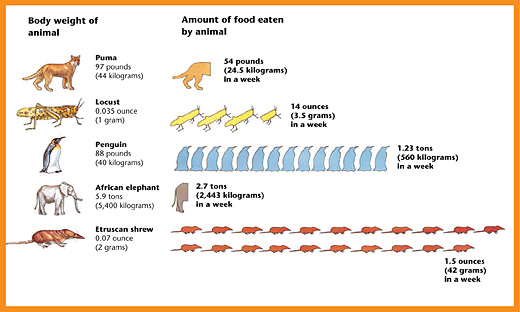Metabolism << muh TAB uh lihz uhm >> is the sum of the chemical processes by which cells produce the materials and energy necessary for life. Metabolism has two phases: (1) anabolism, or constructive metabolism, during which cells combine molecules to assemble new organic materials, and (2) catabolism, or destructive metabolism, during which cells break down molecules to obtain energy and release heat. All organisms conduct both phases constantly. This article specifically discusses human metabolism, but the processes are similar in some other animals as well.

Control of metabolism.
Hormones control both the rate and direction of metabolism. For example, thyroxine, a hormone secreted by the thyroid gland, plays a key role in determining the rate of metabolism. Hormones secreted by special cells in the pancreas determine whether most of the body’s metabolic activity will be anabolic or catabolic. The body conducts more anabolic than catabolic activities after a meal. Eating increases the level of glucose in the blood. The pancreas responds to this high level of glucose by releasing the hormone insulin. Insulin serves as a trigger for cells to begin anabolic activities. When the level of glucose is low—for example, when a person is fasting—the pancreas releases the hormone glucagon. Glucagon signals the cells to conduct more catabolic processes.
The rate of metabolism when a person is at rest is called the basal metabolic rate (BMR). The BMR is a measure of the heat produced by metabolism. This rate varies among people according to sex, age, and body size. Dietitians measure the BMR to determine a person’s caloric needs. At one time, physicians used the BMR to detect an overactive or underactive thyroid gland. Since the 1970’s, doctors generally have diagnosed such disorders with tests that measure the blood levels of thyroid hormones.
Raw materials of metabolism.
Most series of metabolic reactions involve molecules of glucose, fatty acids, or amino acids. The diet is the basic source of these molecules. During digestion, enzymes split dietary proteins into amino acids, dietary fats into fatty acids and glycerol, and dietary carbohydrates (starches and sugars) into simple sugars, particularly glucose. These compounds are then absorbed and transported by the blood to the cells.
Anabolism
produces complex compounds by combining simpler molecules. During anabolism, cells combine amino acids to form structural proteins and functional proteins. The body repairs and replaces tissues with structural proteins. Functional proteins perform specific jobs. Functional proteins include enzymes, which speed up chemical reactions; antibodies, which help fight disease; and many hormones, which regulate various body processes.
Cells convert glucose and fatty acids to energy storage compounds during anabolism. Cells in the liver and the muscles combine molecules of glucose to form a storage compound called glycogen. Cells in the body’s adipose (fatty) tissues combine fatty acids with glycerol to form body fat. By a complex series of reactions, excess glucose and amino acids also can be converted into body fat.
Catabolism
is the breaking down of glucose, fatty acids, and amino acids to obtain energy and produce heat. Compounds involved in catabolism come either from newly digested food, the breakdown of storage glycogen or fat, or the breakdown of body protein.
Glucose catabolism has two steps. The first step, glycolysis, works without oxygen. Glycolysis breaks down glucose into pyruvic acid and releases a small amount of energy. If oxygen is present, the pyruvic acid is converted to a compound called acetyl-coenzyme A (abbreviated acetyl-CoA). The second step of glucose catabolism, the Krebs cycle, then takes place. In the Krebs cycle, a series of chemical reactions combines acetyl-CoA with oxygen to produce carbon dioxide and water, and to obtain energy.
The catabolism of fatty acids also has two steps. First, enzymes convert fatty acids to acetyl-CoA. Acetyl-CoA then enters the Krebs cycle. Although amino acids generally serve as building blocks for new proteins, the body may use excess amino acids as an energy source. Before they can be catabolized, amino acids must be chemically altered in the liver or other tissues. They can then enter the Krebs cycle.
About 60 per cent of the energy released during catabolism takes the form of heat. The rest of the energy is stored in the chemical bonds that link atoms in a compound called adenosine triphosphate, or ATP. When the body needs this energy, enzymes break the bonds and release it.
